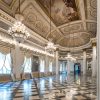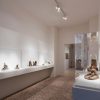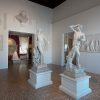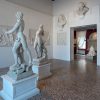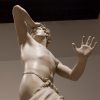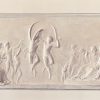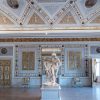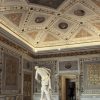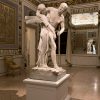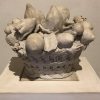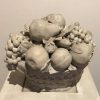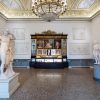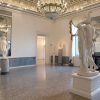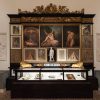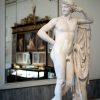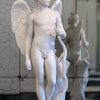Ballroom. This sumptuous and opulent ballroom is unique in the palace for the refinement of its Empire-style decor. Lorenzo Santi began the works on the design in 1822, and Giuseppe Borsato completed the decoration in 1838. At both ends, the room is bounded by loggias intended to house the orchestra; above the gilded Corinthian capitals of these fluted columns in polished stucco are two small apses that make the upper area of the ballroom into an oval. The centre of the ceiling is frescoed with Peace, surrounded by the Virtues and the Geni of Olympus. Painted by Odorico Politi, the work is a clear reference to the restoration of the Hapsburgs after the Napoleon period. At the end of the room there are two sculptures in Vicenza stone by Antonio Canova depicting Orpheus and Eurydice. Produced in 1777, they come from the garden of the Villa Falier in Asolo. The handling of the bodies and of their relation with the space around them clearly reveals how the young artist’s Late Baroque style was being changing for a revolutionary feeling in sculptural mass.
Canova, from the drawing to the model: from an idea to the form in space
The museum houses a large nucleus of autograph drawings from the collections of illustrious figures that knew Canova (Leopoldo Cicognara, Bartolomeo Gamba, Francesco Aglietti etc.). Part of the first stage of his creative process, the drawings used two techniques that the sculptor chose depending on how satisfied he was with the ‘idea’: in pencil whilst studying the subject and composition and in ink with sure, subtle strokes for subjects that were mature in their gesture, pose and expression, but still had to be perfected, for example by comparing them with the real thing, with the model before him. Some of the sheets depict works that became famous marbles ( The Three Graces, The Boxers Creugante and Damosseno ); others reached the model stage but were never completed in marble; the ones dedicated to his beloved theme of dance are particularly delightful.
The outstanding group of Canova’s autograph models is a magnificent demonstration of his great inventive success and exceptional ability to conceive and concretise the form with immediacy, free in space. In the sculptor’s hands malleable materials such as wax and clay (either fired or left raw) either take on a concrete shape or substantiate the drawing in space, in particular in the case of articulate groups of figures. Outstanding in this group is the terracotta model that conveys the initial idea of the famous marbles of Love and Psyche before it was changed, the small raw clay for the Repentant Magdalene , and the studies for the figures of what was to be the Funerary Mausoleum for Maria Christina of Austria in Vienna. Of particular dramatic conception is the articulate group of numerous figures with Hercules firing arrows at his children , effectively portrayed in wax. The uncompleted project for the Funerary Monument to Francesco Pesaro
is not a true model but a miniature in wood and wax.
Canova, his beginnings
Antonio Canova was born in Possagno in 1757, at the foot of the Treviso Prealps to a family of experienced stonecutters. He received his technical training from his grandfather and the workshops of skilled late Baroque sculptors between Asolo and Venice; it was not long before he met members of the more modern and influential circles of Venice and it was there that he began to develop his fundamental classicist direction and received his first commissions.
With Orpheus and Eurydice (1775-76) – statues in soft stone that were originally on the pillars of the villa gate belonging to Senator Giovanni Falier in Asolo – the sculptor barely eighteen years old, completed his first evocative large-dimensioned sculpture, revealing he was still under considerable influence from the painting style of the Eighteenth century. This changed immediately with his first sensational masterpiece Daedalus and Icarus (1777-79) [in the next room 6/3], which enabled him to go to Rome and finish his training. He made his name once and for all as the most advanced and skilled sculptor in Rome with the creation of the Funerary Monuments to Popes Clement XIV (Basilica dei SS. Apostoli, 1783-87) and Clement XIII (the Venetian Carlo Rezzonico in Saint Peter’s, 1783-92). On display here are the plaster casts of various parts: Bust of Pope Clement XIII; Bust of Religion; reliefs with Charity and Hope. While he was waiting for this last, extraordinary commission, as a personal artistic exercise Canova sculptured a series of Bas-reliefs in plaster (1787-92), inspired by episodes from the great Greek-Roman classical poems of Homer, Virgil, and by Socrates. What he portrays here is a synthesis inspired by both the Ancient and Donatello’s Florentine Quattrocento: figures with clear profiles, few planes of depth scaled down parallel; the role of the pose line and the smooth background. These were never completed in marble but reproduced in plaster several times, at times with slight variations, and were mainly given to the artist’s friends, admirers and potential clients. On display here are three of his most famous bas-reliefs: The Death of Priam; The Dance of sons of Alcinous; Hecuba and the Trojans offer Pallas the Peplos. Together with other plasters these were sent to Venice in 1795-96 to the procurator Antonio Cappello, who immediately made them available to young Venetian artists in his apartment in this same building of the Procuratie Nuove. It was especially with such innovative works that as early as the end of the eighteenth century Canova created and diffused a neo-classical canon that was destined to resounding international success.
Canova and Venice : Daedalus and Icarus, first masterpiece
In the centre of the magnificent ‘Sala delle vedute’ [Room of views] by the painter Giuseppe Borsato (1811 and later) – a successful Venetian interpreter of Percier and Fontaine’s Napoleonic ‘Empire Style’ – is the marble group of Daedalus and Icarus , one of Antonio Canova’s earliest masterpieces. The work was commissioned by the procurator Pietro Vettor Pisani for his Palazzo Pisani Moretta overlooking the Grand Canal. Just twenty years old, with amazing geniality here Canova achieved a suggestive contrast between the classical model (Icarus) and the characteristically Venetian particular eighteenth-century pictorial naturalism, inspired by Giambattista Piazzetta’s ‘heads’ (Daedalus). This skilful composition links the two figures around an ‘empty’ void, enclosed circularly by the thread that goes from Daedalus’ wing and hand. Expressing a form of emotional and dramatic communication, with his face contracted by doubt, the father Daedalus is attaching the wings made of feathers held together by wax to the arms of his young son Icarus who is humouring him in all tranquillity, looking forward to the joy of the flight that will allow him to flee the labyrinth and the threat of the Minotaur. The treatment of the marble surface is vibrant and still a long way away from the polished purity that was to become a characteristic of Canova. An eloquent trademark of the sculptor, the mallet and chisel lying at the feet of the elderly architect are placed in ideal continuity with the artifice Daedalus. Presented at the ‘Fiera della Sensa’ (Ascension) in 1777 where it met with resounding success, young Canova earned 100 gold zecchins for this work, which he used to travel to Rome for the very first time. It was there that his experience of the Ancient and the support of a variety of different people were to result in his decisive turn to the classical and his rise to international renown.
In the passage way towards the ‘Oval Room’ are two early Baroque Fruit Baskets (1774) in marble, done with great skill and sensitivity to decorate the balustrade of the staircase in Ca’ Farsetti.
Canova, the Empire, the Glory: creating the myth
In the last decade of the eighteenth century, thanks to sublime creations such as Cupid, Cupid and Psyche (standing and lying down), Hebe, Venus and Adonis, Hercules and Lichas, Repentant Magdalene, etc. established himself as the ‘new Phidias’, renewer of the purest classical aesthetical or rather ‘neo-classical’ ideals. After working in Vienna on the Funerary Monument for Maria Christina of Austria , the sculptor began working in the Napoleonic field since the aesthetic ideals Canova was championing had been adopted by Napoleon as a symbol of the Empire. The Bonaparte family commissioned him with numerous sculptures, including Paris , the plaster model (1807) of which is on display here. He also sculpted works that had become famous before he had even completed them in marble, some of which he repeated and varied: Perseus, The Boxers, Venere Italica and the Dancers , many funerary bas-reliefs, and the Monument to Vittorio Alfieri in Santa Croce in Florence. Once the Napoleonic Empire had fallen, he returned to Paris in 1815 to reclaim all the art works that had been taken (including the Horses of Saint Mark’s for Venice); once this task had been successfully completed – earning him the title of Marquis of Ischia di Castro from Pope Pius VII – he went to London, where he had a revelation of Phidian art whilst admiring the sculptures of the Parthenon. His late works included other renowned creations such as Theseus and the Centaur, Mars and Venus, and Endymion . After 1818 he concentrated on the new church in his native town (Possagno Temple); here it was in the works that were destined for the church that he revealed a transformed sensitivity for regarding the romantic style. He died in Venice on 13 October in 1822 in the home of his friend cafe-owner ‘Florian’ Antonio Francesconi in Bacino Orseolo, just a stone’s throw away from today’s Correr Museum.
The extraordinary and almost ‘mythical’ international renown that Canova enjoyed during his lifetime became a cult after his death; it lasted a considerably long time and united the value of art with the popular risorgimentale feeling of Italianism and national liberation he had expressed in his career, actions and evocative works. Testimony to this is the exceptional Canova Mobile that was assembled by the wealthy Venetian merchant Domenico Zoppetti for his working tools, sketches, drawings (most of which were by his collaborators – facsimile here), autograph paintings (Canova loved painting and painted well for pleasure – facsimile here), personal keepsakes, portraits, nineteenth-century ‘Canova-mania’ objects. After having been the centre piece in the small museum Zoppetti created in his home in the Strada Nuova, the piece of furniture came to the Correr Museum collections in 1849; it was taken apart in 1952 and then reassembled with the integral recovery of the carved decorative parts (2015).
On display in the showcase is one of Canova’s valuable personal items: the Breakfast service in vermeil (five pieces in silver and gold), a masterpiece by the Parisian silversmith JeanBaptiste-Claude Odiot (1810 ca.); in pure Empire style, it exalts the outstanding craftsmanship of the chiselled details and finishing in polished/opaque old. It was a gift from Louise-Maximilienne de Stolberg, wife of Edward Stuart, the Countess of Albany, as thanks for his completion of the Monument to Vittorio Alfieri (Florence, Basilica di Santa Croce, 1810), who was her companion. [given to the Correr Museum by Comité français pour la sauvegarde de Venise with the support of Compagnie Plastic Omnium – 2015]
